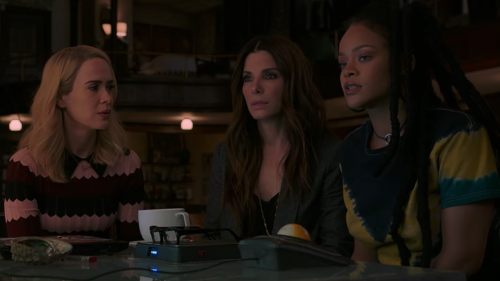The Great Pleasures Of A Heist Movie
Ocean's 8 is almost here. Get your tickets now!
Heist films are gloriously versatile. They can be playful and joyous, taking after Soderbergh’s Ocean’s movies and Logan Lucky. They can be hard-hitting and cynical, following in the footsteps of John Frankenheimer’s Ronin. They have space for images that dance in the mind, like James Cann and his crew watching their thermal lance sear into a safe in Thief. And they have space for language that refuses to be forgotten, like George Clooney and Jennifer Lopez agreeing to take a “time out” before going back to their inevitably clashing lives in Out of Sight. There’s very little that a great heist movie cannot do. But, as diverse as the genre is, even the most diametrically opposed heist pictures have something in common: the heist itself, from its conception to its execution. Be they foolhardy schemes that end in disaster and carnage (The Way of the Gun) or major scores whose success impresses even the most determined of enemies (Fast Five), all heist films need a heist. All those heists need plans. And all those plans must play out, calamitously, flawlessly or otherwise. This structure both allows for a massive variety of tones and styles and guarantees narrative propulsion.
Great heist films take special care introducing us to the players, to their allegiances, to their skills, their interpersonal bonds and tensions. The opening of Ronin introduces the team of ex-spies recruited to steal a mysterious case and demonstrates how each of them operates. Robert De Niro’s Sam is methodical in his preparation and professional with his colleagues. He’s both the protagonist and one of the team’s best operators. Sean Bean’s Spence is boastful and tries to butter up his teammates. He’s a fraud who’s all but literally kicked out of the movie before the heist proper.
The set-up also establishes the stakes and the endgame, and with them some, but not all, of the complications that may arise. The Way of the Gun’s Parker (Ryan Phillipe) and Longbaugh (Benicio del Toro) stand to get rich; they just have to endanger Robin (Juliette Lewis), a young woman in the late stages of pregnancy, and survive the wrath of the wicked couple (Scott Wilson and Kristin Lehman) for whom she was serving as a surrogate mother. In addition, the various phases of the set-up allow for miniature dramas and character arcs that feed back into the larger film, distinct moments that the picture might not have time for once things get underway. Jimmy Logan (Channing Tatum) bemusedly helps his daughter Sadie (Farrah Mackenzie) get ready for a beauty pageant. Joe Bang (Daniel Craig) sends his brothers Sam and Fish (Brian Gleeson and Jack Quaid) to acquire supplies for the heist from a mysterious man in the woods who’s dressed as a bear and has the ability to disappear into thin air.
What does a heist film do when the crime itself arrives? From a cinematic standpoint, the actual heist is the moment best suited to spotlight bodies in motion. No other art form captures movement the way movies do. It’s one of the medium’s greatest pleasures. And the story structure that heist pictures share needs motion during its climax. But there’s no law of cinema that says every heist has to play out the same way (not counting the Hays Code’s infamous prohibition on crime and criminals ever being portrayed as sympathetic and/or successful).
So long as the plan is in motion, the heist at the center can be anything. And it can play out any way. It can go flawlessly, as in Thief (only for complications to arise in the aftermath). It can fall to pieces and end in gunfire, as in Heat. It can be a diversionary robbery that paves the way for a bigger score, as in this year’s delightfully slimy Den of Thieves. It can be a totally bonkers car chase that tears a city apart with a giant safe being dragged behind two stolen police cars, as in Fast Five. It can be a macho farce, a la the low-key Kurt Russell vehicle The Art of the Steal. It can be a piece of cinematic trickery that plays with who is doing what, when, where and why, as Logan Lucky proves gloriously.
Within the planning/execution framework the heist film’s narrative engine provides, there’s room for all sorts of stories. Great heist pictures have been everything from down-to-earth character pieces to neon hyper-realities. They’ve ended on every beat from Heat’s melancholy transcendence to The Way of the Gun’s bitter but not hateful acceptance to Logan Lucky’s celebratory reunion and marvelous little sliver of “or have they?” There’s space for all those styles, all those stories, all those endings and more. Ronin and Baby Driver are miles apart as movies, but they’re both heist pictures. Both turn on plans to steal something, the execution of those plans and the subsequent fallout. Their cinematic pleasures are simultaneously unique and shared. That’s the form’s glory.



